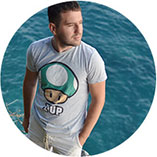Цель заброшена
Автор не отписывался в цели 10 месяцев 5 дней
Coursera: Medical Neuroscience
Больше года назад я начала этот курс, забросила, и не могу перестать думать о нём. Это похоже на влюбленность, мыслями все время возвращаюсь к лектору, к материалу, ХОЧУ. Просто ХОЧУ. До трясучки, мой мозг хочет изучать... работу мозга. Я уже скачала кучу англоязычных учебников по нейробиологии, этот курс же может стать моей ежедневной ложкой мёда и вдохновения.
Advanced Level Approx. 96 hours to complete
... продвинутый уровень, чтобы до него допустили нужно было сложные тесты пройти, спасибо меду за это! И он занимает почти 100 часов обучения. Кое-что я могу просматривать на повышенной скорости и типа повторения. Большую часть задания могу не делать, т.к. не покупала курс и никто мои сочинения проверять не будет. Может, когда-нибудь, я вернусь уже за кредитами... но пока это просто желание и жадность, а еще -- непреодолимая тяга к познанию. *__*
Критерий завершения
курс завершен
-
WEEK 1 Getting Started in Medical Neuroscience
Let's get started in Medical Neuroscience! Each module in Medical Neuroscience will begin with a brief description like this that provides you with an overview of the module. In this first module, you will get to know something about Prof. White and his career in neuroscience; you will understand the scope of Medical Neuroscience, its learning resources, your responsibilities for maximizing your benefit in this course, and you will learn Prof. White's tips on how best to study and learn.</p><p> At the end of this module, please take the ungraded preliminary quiz, "Are you ready for Medical Neuroscience", to self-assess your background knowledge. Your score on this quiz will not count toward your overall score in this course. However, you should be able to pass this quiz (score 70% or better) if you are ready for the academic challenge of this course. Students who are likely to achieve their goals in Medical Neuroscience should be able to successfully answer nearly all of the quiz questions on their first attempt and feel comfortable with assessment questions at this level of knowledge.
2 hours to complete
-
Welcome
-
Neuroanatomy: Introducing the Human Brain
-
-
WEEK 2 Neuroanatomy: Surface Anatomy of the Human CNS
We now begin in earnest our lessons on neuroanatomy with the surface of the human brain, including a brief run through the cranial nerves and the blood supply to the CNS. In this module, you will learn the basic subdivisions of the vertebrate nervous system; however, your focus should be on the cerebral cortex. Along the way, you will be challenged to "build a digital brain" that should help you generate and improve your mental “model” of the cerebral hemispheres of the human brain. Another great way to refine your mental model is through sketching and crafting, so please do the learning objectives that are designed to help you make visible (and tangible) your understanding of the cerebral hemispheres.
12 videos (Total 129 min), 2 readings, 2 quizzes
-
Neuroanatomy: Internal Anatomy of the Human CNS
-
-
WEEK 3 Neural Signaling: Electrical Excitability and Signal Propagation
We now turn our attention from the tangible (human neuroanatomy) to the physiological as we explore the means by which neurons generate, propagate and communicate electrical signals. After exploring those structures in the human brain that are visible to the unaided eye, we must now sharpen our focus and zoom-in, as it were, to the unitary level of organization and function in the central nervous system: to the level of individual neurons and their component parts that are crucial for neural signaling.
9 videos (Total 142 min), 1 reading, 1 quiz
SEE ALL
-
WEEK 4 Neural Signaling: Synaptic Transmission and Synaptic Plasticity
Let’s continue our studies of neural signaling by learning about what happens at synaptic junctions, where the terminal ending of one neuron meets a complementary process of another excitable cell.
13 videos (Total 226 min), 2 readings, 2 quizzes
SEE ALL
-
WEEK 5 Sensory Systems: General Principles and Somatic Sensation
We have reached a significant juncture in Medical Neuroscience as we turn our attention to the organization and function of the sensory systems. We will begin our studies with the somatic sensory systems, which includes subsystems for mechanical sensation and pain/temperature sensation. But before we get there, it is worth considering first some organizing principles that will set the stage for studies of somatic sensation and all the other sensory systems of the body.
16 videos (Total 257 min), 2 readings, 2 quizzes
SEE ALL
-
WEEK 6 Sensory Systems: The Visual System
This module will provide lessons that are designed to help you understand the basic mechanisms by which light is transduced into electrical signals that are then used to construct visual perceptions in the brain. Your studies of the visual system will benefit you at this point in the course, but also in later studies when we use the visual system as a model for understanding general principles of developmental plasticity. Lastly, it is worth noting how much of the forebrain contains elements of the visual pathways. Thus, injuries and disease in widespread regions of the brain may have a clinically important impact on visual function. All the more reason to learn these lessons well as you progress in Medical Neuroscience.
12 videos (Total 161 min), 2 readings, 2 quizzes
SEE ALL
-
WEEK 7 Sensory Systems: Audition, Vestibular Sensation and the Chemical Senses
Our survey of the sensory systems continues as we now turn our attention to the auditory system, the vestibular system, and the chemical sensory systems. As you study this content, notice the similarities and the differences that pertain to the general mechanisms of sensory transduction and the broad organization of the central pathways in each of these sensory systems. In particular, note the similarity in transduction mechanisms for audition and vestibular sensation; and note the “logic” of sensory coding in the chemical sensory systems.
22 videos (Total 272 min), 3 readings, 3 quizzes
SEE ALL
-
WEEK 8 Movement and Motor Control: Lower and Upper Motor Neurons
We come now to another pivot in Medical Neuroscience where our focus shifts from sensation to action. Or to borrow a phrase made famous by C.S. Sherrington more than a century ago (the title of his classic text), we will now consider the “integrative action of the nervous system”. We will do so in this module by learning the basic mechanisms by which neural circuits in the brain and spinal cord motivate bodily movement.
18 videos (Total 252 min), 2 readings, 2 quizzes
SEE ALL
-
Movement and Motor Control: Understanding the Paradigm of Eye Movements
-
-
WEEK 9 Movement and Motor Control: Modulation of Movement
Next, we will consider two major brain systems that modulate the output of upper motor neuronal circuits: the basal ganglia and the cerebellum. Take note: the output of these systems is NOT directed at lower motor circuits directly; rather, their output engages the motor thalamus and brainstem upper motor neuronal circuits. Thus, the actions of the basal ganglia and cerebellum are to modulate, rather than command, the activities of upper motor neurons. As you study the lessons in this module, appreciate how the basal ganglia and cerebellum function in a somewhat complementary fashion to modulate the initiation and coordination of movement, respectively.
11 videos (Total 154 min), 2 readings, 2 quizzes
´´´´
We conclude our survey of movement and motor control by considering the visceral motor system, perhaps better known as the autonomic nervous system. As you study this lesson, consider how the disparate physiology of the viscera has impact not only on the internal state of the body, but also on implicit processing in the forebrain. We will return to this matter when we consider the neurobiology of emotions near the conclusion of Medical Neuroscience
8 videos (Total 107 min), 1 reading, 1 quiz
-
Movement and Motor Control: Visceral Motor Control
-
-
WEEK 10 The Changing Brain: The Brain Across the Lifespan
This module represents another turning point in Medical Neuroscience. Now that we have surveyed human neuroanatomy and our sensory and motor systems, we are ready to take a step back and consider how this magnificent central nervous system came to be the way that it is. We will also learn how the brain re-wires itself across the lifespan as genetic specification, experience-dependent plasticity and self-organization continue to interact, re-shaping the structure and function of neural circuits throughout the central nervous system.
23 videos (Total 295 min), 3 readings, 3 quizzes
SEE ALL
-
WEEK 11 Complex Brain Functions: Associational Cortex
It may surprise you to know that in all of our studies of the neural systems for sensation and action, we have yet to properly account for the organization and function of roughly 75% of the entire cerebral mantle. Thus, only 25% of the cerebral cortex is accounted for by the modal sensory and motor cortical areas. The majority of the human cerebral cortex is multi-modal cortex that associates signals derived from one or more modal systems. We now turn our attention to this “associational cortex” as we consider more complex aspects of brain function.
11 videos (Total 169 min), 1 reading, 1 quiz
SEE ALL
-
WEEK 12 Complex Brain Functions: Sleep, Emotion and Addiction
In this concluding module of Medical Neuroscience, we will consider the neurobiology of sleep and the neurobiology of emotion, including addiction. Both topics involve explorations of complex, widely distributed systems in the forebrain and brainstem that modulate states of body and brain.
13 videos (Total 205 min), 2 readings, 2 quizzes
SEE ALL
-
WEEK 13 Comprehensive Final Exam
This module contains materials that will help you prepare for the final challenge in Medical Neuroscience: our clinical case-based, Comprehensive Final Exam.
1 video (Total 22 min), 1 reading, 5 quizzes
SEE ALL
6 minutes to complete
Closing Remarks
Please allow me a few more moments of your time to express my thanks for all your efforts to make it through Medical Neuroscience, and to wish you well on all your future endeavors!
1 video (Total 6 min)
SEE ALL
- 1733
- 23 февраля 2020, 18:27
Не пропустите новые записи!
Подпишитесь на цель и следите за ее достижением



